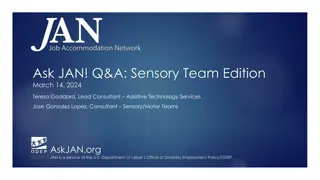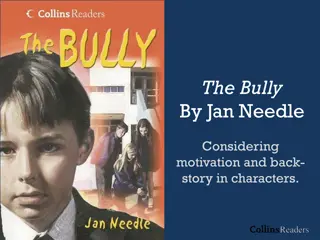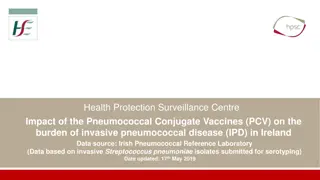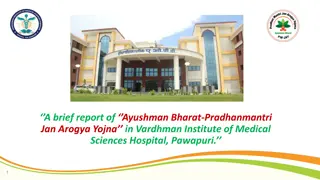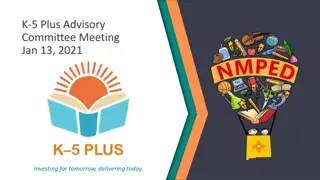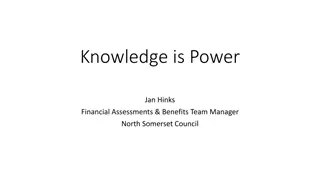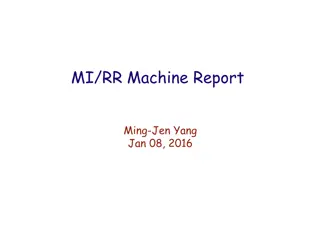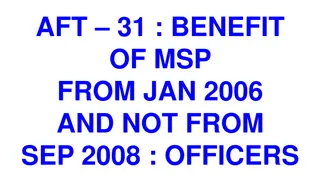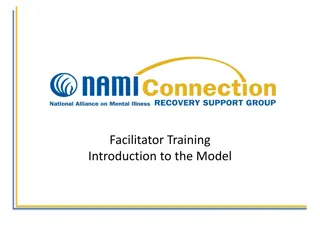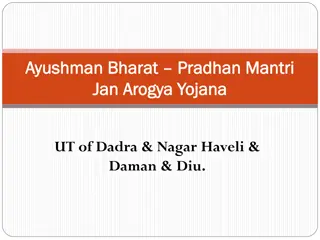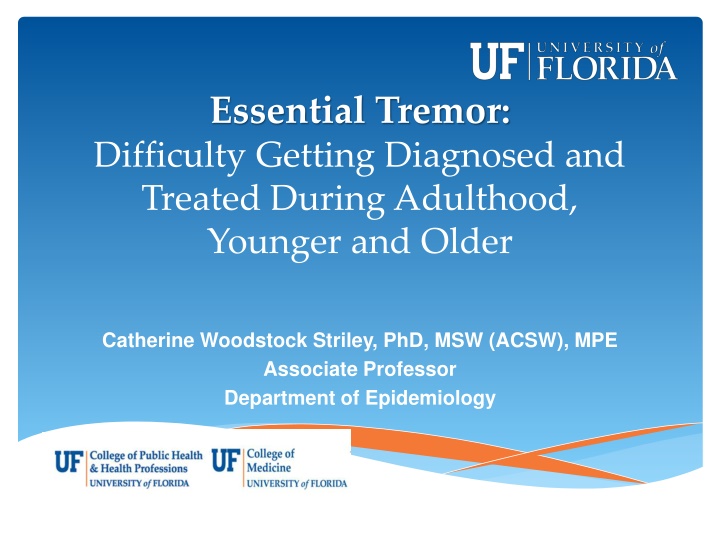
Difficulty Diagnosing and Treating Essential Tremor: Insights from Catherine Striley
Explore the challenges faced in diagnosing and treating Essential Tremor (ET), shared by Catherine Striley, as she discusses stories, research findings, and comorbidities associated with movement disorders like Tourette's Disorder and Dystonia. Discover communication preferences and treatment experiences through personal narratives and academic studies.
Download Presentation

Please find below an Image/Link to download the presentation.
The content on the website is provided AS IS for your information and personal use only. It may not be sold, licensed, or shared on other websites without obtaining consent from the author. If you encounter any issues during the download, it is possible that the publisher has removed the file from their server.
You are allowed to download the files provided on this website for personal or commercial use, subject to the condition that they are used lawfully. All files are the property of their respective owners.
The content on the website is provided AS IS for your information and personal use only. It may not be sold, licensed, or shared on other websites without obtaining consent from the author.
E N D
Presentation Transcript
Essential Tremor: Difficulty Getting Diagnosed and Treated During Adulthood, Younger and Older Catherine Woodstock Striley, PhD, MSW (ACSW), MPE Associate Professor Department of Epidemiology
Agenda A little about my ET A story about relationships Findings from a pilot study of ET and other disorders (Tourette s Disorder and Dystonia) A story about trying to get a diagnosis Findings from the Hope NET funded study of undergraduates at UF Discussion Questions
Needs Improvement and Spazz The UF CTSI is supported in part by NIH awards UL1TR001427, KL2TR001429 and TL1TR001428
Stories Ill never forget A man and his wife said they had been RVers that spent their time driving to church campgrounds to help with repairs. When he developed a dystonia that made it impossible to drive, their Christian friends cut them off socially, giving them a cut direct when approached at church The UF CTSI is supported in part by NIH awards UL1TR001427, KL2TR001429 and TL1TR001428
Resistant to treatment Asthma + ET means medicines work against each other! Scared I d need to have increasing dosage Once I started, whole system settled I realized it had been affecting my balance I felt much more centered and less unsettled The UF CTSI is supported in part by NIH awards UL1TR001427, KL2TR001429 and TL1TR001428
Comorbidity and Diagnostic Communication Preferences for Patients with Movement Disorders PI: Catherine Striley, PhD, MSW, MPE UF Health Movement Disorder Clinic Patients The UF CTSI is supported in part by NIH awards UL1TR001427, KL2TR001429 and TL1TR001428
Aims We aimed to ascertain behavioral health comorbidities, care receipt and communications preferences of ET, TD and Dystonia patients The UF CTSI is supported in part by NIH awards UL1TR001427, KL2TR001429 and TL1TR001428
Methods Participants were interviewed with the Diagnostic Interview Schedule (IV) and with a health assessment and communications survey (n=43; 25 80 years of age) Medical records were also reviewed A Town Hall was held to ensure results were communicated to participants The UF CTSI is supported in part by NIH awards UL1TR001427, KL2TR001429 and TL1TR001428
Demographics of Pilot Sample: ET, TD and Dystonia Variable Values Freq % Male 20 46.5 Gender Female 23 53.5 African American 1 2.3 Mexican Caucasian 1 40 2.3 93 Race Biracial 1 2.3 Married 28 65.1 Widowed 2 4.7 Marital Divorced Never Married 3 10 6.9 23.3 No 36 83.7 Employed Yes 7 16.3 TS 12 27.9 ET 17 39.5 Diagnosis DYS 14 32.6 N Mean STD (Range) 43 54.4186 16.03 (26,83) Age
Comorbidity (no rule outs) N=43 LT Prevalence LT Prev in Gen Population ASPD 30% 5.8%+ ADD/ADHD 12% 8.1%** Oppositional Defiant Disorder 14% 8.5%** Conduct Disorder 12% 9.5%** Depressive Disorder 37% 16.6%** Bipolar Disorder 12% 3.9%** Social Anxiety Disorder 14% 12.1%** Specific Phobias 14% 12.5%** Agoraphobia 12% Generalized Anxiety Disorder 14% 5.7%** The UF CTSI is supported in part by NIH awards UL1TR001427, KL2TR001429 and TL1TR001428
Comorbidity (no rule outs) N=43 LT Prevalence LT Prev in Gen Population PTSD 12% 9% (at age 75) Any Anxiety Disorder 26% 33% 12% 33% TS ET 28.8%** DYS The UF CTSI is supported in part by NIH awards UL1TR001427, KL2TR001429 and TL1TR001428
Comorbidity LT Prevalence LT Prev in Gen Population (no rule outs) N=43 Alcohol Use Disorder 40% 30%* Nicotine Use Disorder 14% 25%~ Cannabis Use Disorder 2% 7.2%* The UF CTSI is supported in part by NIH awards UL1TR001427, KL2TR001429 and TL1TR001428
Communication Preferences Participants end up having to education physicians, loved ones and friends Participants became quite active in seeking out their own information Participants wish others would know more. They dislike having to educate everyone Some did express stories of stigma and discrimination The UF CTSI is supported in part by NIH awards UL1TR001427, KL2TR001429 and TL1TR001428
Findings on Comorbidity: OCD and BD by TS and BD by ET Disorders Dx Comorbidity Significance TS + TS - Obsessive- Compulsive Disorder + Obsessive- Compulsive Disorder - P=0.07 3 1 9 30 TS + TS - Bipolar Disorder + Bipolar Disorder P=0.09 3 2 9 29 ET + ET - Bipolar Disorder + Bipolar Disorder P=0.09* Less likely 0 5 16 22 The UF CTSI is supported in part by NIH awards UL1TR001427, KL2TR001429 and TL1TR001428
Very Small Study But no additional comorbidities with ET Less anxiety disorders The UF CTSI is supported in part by NIH awards UL1TR001427, KL2TR001429 and TL1TR001428
Hard to get diagnosed Woman who told me she started shaking and she became suicidal. She became convinced that (1) she had Parkinson s and (2) that this was more horrible than death. Her husband convinced her to call Dr. Okun. He asked her to try to drink test. When she had a little alcohol, her tremor improved. She went on to be appropriately diagnosed. A man who begged me to do more ET research, and said that he had spent years going to rural doctors trying to figure out what was wrong with him before he finally received help at the UF Movement Disorder Center The UF CTSI is supported in part by NIH awards UL1TR001427, KL2TR001429 and TL1TR001428
Tremor Prevalence and Help Seeking Behavior among College Students PI: Catherine Striley, PhD, MSW, MPE with Funding from HopeNET (No more Essential Tremor) Foundation
Aims Develop a short survey on tremor symptoms for use among college students that will assess tremor, barriers to care seeking, care seeking, and for those with tremor, embarrassment and effect on future planning. Administer the developed online survey to undergraduate college students (~n=8,000) through an email-link sent by the University of Florida Registrar s Office and through tabling on campus. Describe report of tremor among the college students who respond to the survey. Analyze and disseminate results of the survey to help inform the field and to help shape possible interventions.
Methods The registrar supplied 8,000 email addresses for undergraduate students 18 years and older An invitation to participate in the survey with a link was sent IRB-approved consent was elicited with an information screen and by continuing to the survey Answers recorded in May 2020 were analyzed (n=293) 279 students completed The UF CTSI is supported in part by NIH awards UL1TR001427, KL2TR001429 and TL1TR001428
Results Percent of Respondents Endorsing 60 50 40 30 20 10 0 Noticed fine tremor Known family history of tremor Family member with noticable tremor Tremor unrelated to alcohol since college Anyone else thought had tremor Percent
Results: Family Member Diagnosis 7 with Essential Tremor/Benign Family Tremor/Family Tremor 5 with Parkinson s (1 also with Graves) 4 None known 3 Inflamed nerves/sciatic nerve/brachial nerve damage 2 Arthritis 1 Stroke 1 Dystonia (Spasmodic Torticollis) 1 Anxiety The UF CTSI is supported in part by NIH awards UL1TR001427, KL2TR001429 and TL1TR001428
Results: Hypothetical Barriers Question asked IF you noticed a tremor, would you be worried people would perceive you as Percent Percent The UF CTSI is supported in part by NIH awards UL1TR001427, KL2TR001429 and TL1TR001428 Extreme Very Somewhat Not at all Extreme Very Somewhat Not at all
Results 97 students had noticed their own tremor in college (n=86), or someone else had noticed their tremor (n=74; n=11 that hadn t noticed themselves) The UF CTSI is supported in part by NIH awards UL1TR001427, KL2TR001429 and TL1TR001428
Results Frequency of Tremor Among 97 with Tremor Once Couple of times Once a month Once a week Many days a week Alll the time
Of the 97, did the tremor: Worsen with caffeine? 69% Improve with alcohol? 24% Only happen when anxious? 55% Did you seek help? 9% The UF CTSI is supported in part by NIH awards UL1TR001427, KL2TR001429 and TL1TR001428
Among the 88 who didnt seek help, why? Multiple answers could be selected Most frequent answer: thought it would get better on its own (65) Didn t know where to go (39) Cost or insurance barrier (16) Too embarrassed (10) Family or friends discouraged (5) Other The UF CTSI is supported in part by NIH awards UL1TR001427, KL2TR001429 and TL1TR001428
Among those who said other reason: Better when eat, worse when anxious/goes a way a while if eat Already diagnosed and didn t want to take medication due to side effects Already sought help; didn t help Don t care, known history Didn t think tremors at this age were a thing Have always had Fear Thought it was normal Knew would go away when calm; anxiety Not a problem; not a big deal; no interest The UF CTSI is supported in part by NIH awards UL1TR001427, KL2TR001429 and TL1TR001428 No time
Consequences of tremor, if any 28 suffered embarrassment 14 had been made fun on 7 were denied access to something 5 had been humiliated 1 excluded The UF CTSI is supported in part by NIH awards UL1TR001427, KL2TR001429 and TL1TR001428
Have you avoided anything due to tremor? Writing/typing/writing on board Taking photos/pictures Eating/holding knife/eating certain things Talking Painting/calligraphy Makeup for others/eyeliner Holding something steady Button down shirts Jenga and games 33 said yes; 63 no Of those who said yes, top answer was public speaking and presentations Going into the medical field/surgery
In what way limited career choices? 6 people said they avoided medicine as a career choice 1 person said they avoided law due to having to argue cases in public 1 person said they were told to stay away from art
Regardless of whether or not we have a well specified ET phenotype, we need to treat tremor more seriously as a life changing problem that requires broad public knowledge and treatment!
We need to reduce barriers to care. Knowing where to go and having knowledgeable health professionals are both critically important. Unfortunately, this puts the burden on us to engage with the public health and research communities.
We dont know what patients want. What do we want? We need to shape the research for our family members benefit! These are us and our youth!
We need to participate in longitudinal research and research of all types Donate our brains Lobby to get research funded Contribute to groups helping us, like Hope NET
For more information cstriley@ufl.edu or 352-273-5359 Please feel free to contact me in the future! UF Health Center for Movement Disorders https://ufhealth.org/essential-tremor The UF CTSI is supported in part by NIH awards UL1TR001427, KL2TR001429 and TL1TR001428



